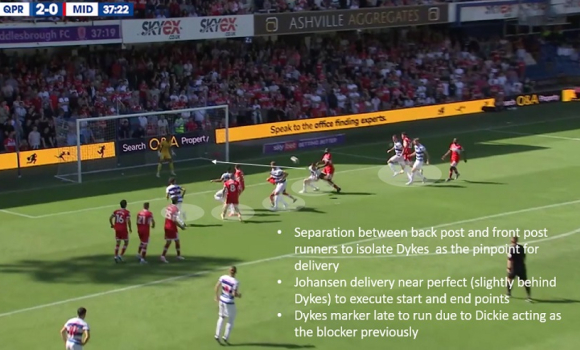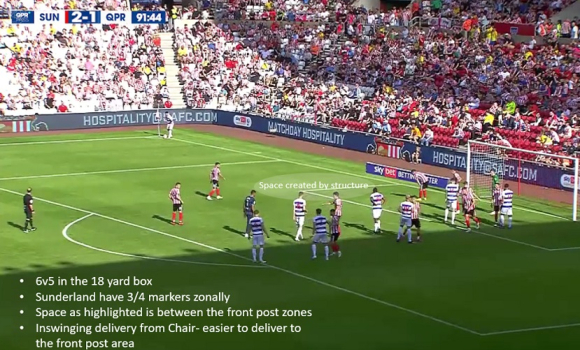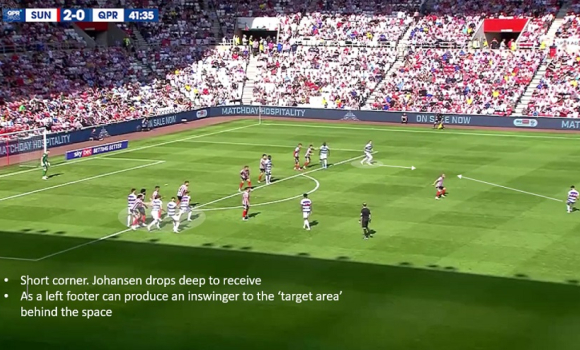The decoy, front post flick and short corner- QPR’s attacking set pieces — Analysis Sunday, 25th Sep 2022 16:17 by Dan Lambert Dan Lambert’s latest analytics column for LFW takes a look at the attacking dead ball variation we’ve seen under Mick Beale and his new set piece coach Harry Watling. QPR went into the international break in optimistic mood. Ten games in, Rangers sit sixth in the table. But to our joy Rangers also sit top of a certain table - for attacking set pieces. Yes, you heard that right, QPR are top (well joint top, but let us have it) for goals scored from set pieces in the league this season with a tally of five. The appointment of Harry Watling not just as set piece coach but also a development coach seems to be paying off from an attacking point of view. Of course, there is the obvious caveat of our defending from set pieces in the early games which remains ropey, but that’s for another discussion. The appointment by the club in general to specialise in the fine margin areas, when very few have done in this division, is the sign of a progressive appointment in the evolving modern game.
As shown by the table above, Rangers sit joint top with Millwall and Rotherham for set pieces scored. In terms of the context of our five goals, three have been from corners, one an Illias Chair spectacular direct free-kick and the other a free kick routine against Middlesborough. Looking at the data for a moment, in terms of set play shots for we rank eighteenth. From the set play xG we’ve accumulated 2.57 xG (ranked fifteenth) so our total is quite an obvious overperformance. xG is a topical debate amongst football fans and it has its strengths and weaknesses for me. For someone that does value xG, the overperformance is not of huge worry to me as of yet, purely due to the varied set piece routines (as I’ll show) and its effect regardless of the quality of the chances. It’s also only been ten games. One to keep an eye out for nonetheless with regards to the pattern. It isn’t just the goals we’ve scored from set pieces so far, but also the different variations which have shown to be effective. In this piece I’ll be analysing the creativity within our set piece routines, the different variations as well as some of the goals scored to show the effect of the routines. Something to note now before delving deeper (which you’ll notice as a theme with our set piece deliveries) is that we opt regularly for an inswinging delivery with only the occasional outswinger. A good article in The Athletic on the different types of set piece deliveries, set piece types and their threat quantified the data and it found that inswinging corners had a lower completion success compared to outswingers in terms of reaching a teammate, but inswingers are a more dangerous delivery than outswingers at finding areas closer to the goal. It may be a bit confusing now, but this is definitely a strong reference point when identifying the themes in what zones we attack our set pieces at. The DecoyOne of the first things I noticed with our set piece routines from the start of the season was the use of decoy runs which is a run that draws or manipulates space for another player or the move of the set piece. This move was evident in the second goal of the home win against Middlesborough which came from a free kick situation.
In this particular goal, and in other set piece set-ups, we adopt the famous England 2018 World Cup set-up known as the “love train” where they line up in a train like form behind one another and attack in different directions once the ball is delivered. From this starting point, the use of the decoy run helps create the space and cause chaos.
Still some work needed by Dykes to finish the chance, with the delivery being slightly behind, but the use of a decoy run, different attacking movements and a blocker to help isolate Dykes in the target area helped to score a well worked set piece routine. The front-post flickAnother set piece variation we’re using is the front post flick. A big and obvious theme within the move is within the starting set-up what I call the ‘six-yard bunch’. The front post run movement in general is something that is a recurring pattern, hence the use of the inswinging delivery as mentioned earlier on in the piece.
As shown above its another inswinging corner to the front post zone. Dykes pulls off the bunch to make the front post movement, flicks it on with the intention of Tyler Roberts off the blindside of the defender by the back post.
Roberts heads the ball downwards, ricocheting off the defender’s arm and on another day, it was a penalty, but from the corner routine you can see what they were trying to do. Another game which this was a common routine was at Watford. Another six-yard bunch, this time a bit more underloaded in the six-yard box. An inswinging delivery from Chair into the front post zone again, not to find a specific teammate or player, but to deliver into the front post area in the hope there is movement to the front post with the chance that any of the attackers make contact with a flick on.
Even in the other set piece variations, the front post movement in an attacking sense is a frequent pattern as you’ll see later on but the front post flick as a tactic is a clever way of adopting the inswinging delivery by chancing on zones with the hope the delivery meets the movement/run. The second phaseSomething we have been accustomed to with our struggles from defensive point of view is the second phase of a set piece with goals conceded against Blackburn and Charlton. The second phase of a set piece is one of the most chaotic parts in the game as it’s a peculiar, awkward phase of play for the defending side, who inevitably shift out of their set-piece positions, but can’t transition into their usual defensive shape, and briefly lack proper organisation. As much as the second or even third phase of a set piece being chaotic from a defensive point of view, from an attacking point of view it’s about keeping the ball alive after the first phase, maintaining control and building again from the second phase. A big example of this is the use of Ethan Laird and Kenneth Paal to an extent on the edge of the box, to collect second balls and keep the set piece alive in the second phase.
Starting with the memorable Seny Dieng goal, it was scored off the second phase. Naturally with this one, the big advantage Rangers have is with Dieng up, it’s an overload in the box.
Again, the front post movements are there to attack the inswinger with Dieng to do so, but it gets cleared back out to Chair, which gives Rangers the opportunity to recycle.
The interesting thing with the second phase set-up (or lack of) is the fact Sunderland operate a flat ‘back seven’ all deep and more zonally.
Clever from Chair, a shorter delivery reaches the target area with Dieng to leap a lovely header home. None of the Sunderland zonal markers can reach the cross and the keeper comes off his line, gets stuck in two minds and is too far off his line to prevent the header in any way. Another game in which we were big on the second phase of set pieces was the most recent game against Stoke, where we created a lot of good chances in terms of capitalising on the chaos of Stoke’s structure.
In this instance it’s a free kick in a deceiving position as it is very close to the corner flag. It’s perhaps a surprise that with six runners attacking the box we didn’t opt for an outswinger to find the spare man, particular at the back post as shown above. But instead, we opt for an inswinger to the front post zone again, every runner makes a diagonal run to that area but the ball gets cleared.
The Stoke line squeeze, two come out to press Paal on the ball, and the shape is a bit chaotic from Stoke with both Chair and Willock on the far side. Paal delivers a whipped cross into the box in the space behind the Stoke backline, with Chair moving off the blindside of Wilmot.
The cross meets the run of Chair creating a dangerous situation off of the second phase of the set piece. Unfortunately, the move isn’t executed but the example highlights the importance of taking advantage of the second phase of a set piece- keeping the ball alive. Another example of this is the Dunne headed chance (albeit a possible offside) but this chance was probably more from the third phase of the set piece than the second. The dreaded short cornerThis is probably the corner that frustrates the average football fan the most. The optimism of a corner, the crowd get on their feet, and then the huge “SIGHHHH” as the corner is taken short… but I do think the short corner does have its benefits. Firstly, it can create overloads whether it be a 2v1 or a 3v2 to create a better crossing angle, just like a situation in open play. The two I’ll analyse are two variations of a short corner- the basic short corner (Johansen goal) and a well worked short corner.
The goal against Millwall was very much a smart goal to score. Millwall were wandering back slowly to get into their structure, there’s a tonne of space by the front post area of the goal, and Chair uses his initiative to take the short early and allow Johansen to receive on the half turn into loads of space. The short corner triggered the movement of Millwall back towards goal to close Johansen down, Shackleton slides completely past him with Johansen needing to keep his composure around the pressure in order to finish it home. A really simple move, helped by the intelligence of Chair to take advantage early and a good finish from Stef.
The other short corner routine used, in a completely different set-up was used away to Sunderland in a routine that saw Rangers go close to scoring.
Similar to the Middlesborough goal set-up, we spread our players across the box for one of a few reasons: either to create uncertainty about which way we aim to deliver the ball; to create an aerial mismatch on one side or another; or create space so that the target area (in this instance on the left) has more space for movement but also the two players on the right to provide back post coverage for second balls.
As shown Johansen drops towards Chair to receive to the ball without pressure. The line held by Sunderland has given Johansen space to deliver the ball behind the line.
As Johansen delivers the inswinger, the runners in the target area move towards the point of delivery with 4v4 attacking the ball.
Dickie wins the first contact, but unfortunately the ball goes slightly wide from the effort. A very effective routine at finding the man from a different angle using the short, and on another day would go in the back of the net. Overarching themes- Majority of our corners are inswingers- and clearly look to deliver to the front post area for flick-ons. With the creativity in set piece situations being impressive, I’d expect to see more routines and more goals from attacking set piece situations. But for now, it’s certainly pleasing! Links >>> More like this at Dan’s SubStack >>> What have we learned so far? If you enjoy LoftforWords, please consider supporting the site through a subscription to our Patreon or tip us via our PayPal account loftforwords@yahoo.co.uk. Pictures — QPRPlusPass The Twitter @DanLambert__ Action Images Please report offensive, libellous or inappropriate posts by using the links provided.
You need to login in order to post your comments |
Rochdale Polls[ Vote here ] |
We in turn value your personal details in accordance with our Privacy Policy.























